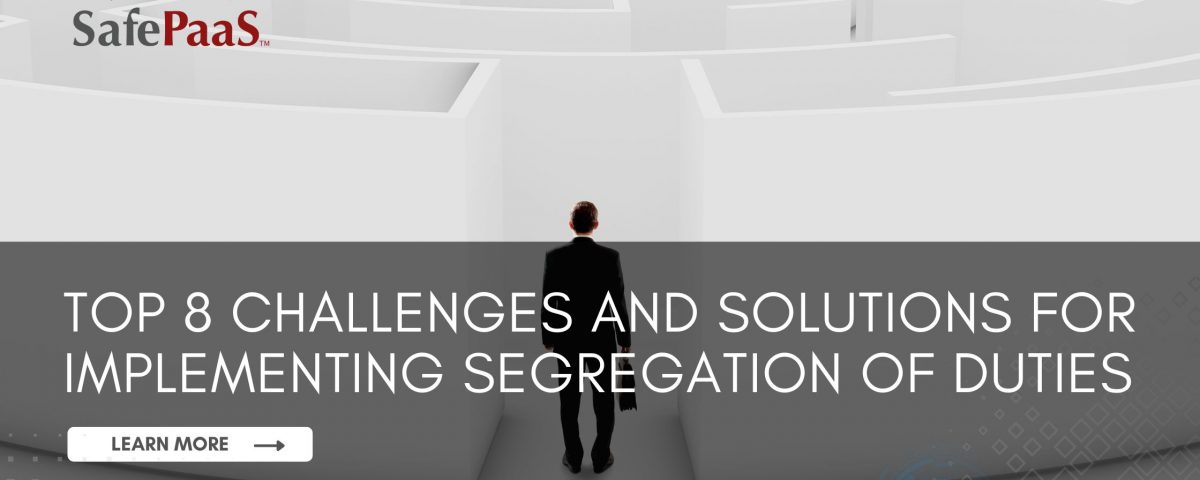Challenges and Solutions Implementing Segregation of Duties


Top 8 Challenges and Solutions for Implementing
Segregation of Duties and the Role of Access Governance
In intricate digital business operations, safeguarding integrity and security is paramount. One indispensable tool in achieving this goal is the practice of Segregation of Duties (SoD). SoD is a formidable barrier against fraud, errors, and unauthorized activities by methodically dispersing key responsibilities among individuals or teams. Yet, the path to implementing successful SoD is riddled with hurdles.
In this tenth and final installment of our comprehensive SoD series, titled "Top Ten SoD, Google Searches - Answered," we unravel the common challenges in SoD implementation, provide solutions, and reveal how policy-based access governance can be key in streamlining the SoD management process.
Challenge 1: Identifying Critical Processes
Solution: Initiate a comprehensive risk assessment to pinpoint processes susceptible to risk. Collaboration with different departments and teams will provide insights into which processes demand prioritized SoD implementation.
Challenge 2: Determining the Right Division of Duties
Solution: Achieving the right balance in dividing responsibilities is paramount. Seek expert advice and adopt industry best practices to determine the most effective way to segregate duties. This may involve revising existing workflows and processes.
Challenge 3: Maintaining Efficiency
Solution: SoD should not compromise efficiency - leverage technology to automate routine tasks and approvals. Workflow automation ensures tasks are routed to the right individuals at the right time, streamlining processes while preserving compliance.
Challenge 4: Continuous Monitoring and Enforcement
Solution: Implement regular audits and monitoring mechanisms. Technology solutions can track and report on SoD policy compliance, promptly identifying and addressing deviations.
Challenge 5: Balancing Cost and Benefit
Solution: SoD implementation may necessitate investments in technology and training. Calculate potential cost savings from fraud prevention, error reduction, and regulatory compliance. This can help justify initial costs and ensure a positive return on investment.
Challenge 6: Ensuring Consistency
Solution: Establish clear policies and procedures for SoD and comprehensively document them. Consistency is key, and these processes must be consistently followed across the organization. Regularly update and review these policies to adapt to changing business needs and regulations.
Challenge 7: Adapting to Technological Changes
Solution: In a rapidly evolving technological landscape, keeping SoD controls up-to-date is critical. Regularly assess and update your technology infrastructure to address emerging threats and vulnerabilities.
Challenge 8: Scaling for Growth
Solution: As your organization grows, the complexity of SoD implementation may increase. Consider scalable solutions and ensure your SoD framework can adapt to your organization's changing needs and size.
The Role of Access Governance
Policy-based Access governance is pivotal in overcoming many of these Segregation of Duties implementation challenges. Access Governance solutions help manage and enforce SoD policies by:
Automating Compliance: Policy-based Access Governance solutions automate the enforcement of SoD policies, reducing the risk of human error and ensuring continuous compliance.
Real-time Monitoring: They provide real-time monitoring and reporting capabilities, alerting organizations to any violations or deviations from SoD policies as they occur.
Access Control: Access Governance solutions allow organizations to control user access to critical systems and data, ensuring that individuals only have access to the resources necessary for their roles.
Streamlined Auditing: These solutions simplify the auditing process, providing a comprehensive and easily accessible audit trail of all access and permissions changes.
Implementing Segregation of Duties is crucial for the integrity and security of your business operations. While challenges are inevitable, solutions exist to address them effectively. With their automation and real-time monitoring capabilities, access governance solutions are key in simplifying SoD implementation and ensuring ongoing compliance. By proactively addressing these challenges and leveraging the right technology, your organization can fortify its internal controls, reduce risks, and maintain the trust and security of your operations in today's digital business environment.
More blogs in the series

Segregation of Duties in IT Systems
While the concept of Segregation of Duties may appear redundant to some, its role in safeguarding against financial risks and preserving organizational reputation from data mishandling underscores its pivotal importance in maintaining effective access management, data security, and compliance.

Segregation of Duties in Fraud Prevention
Without SoD, a business may inadvertently create an environment ripe for fraud. Imagine a scenario where a single employee has the authority to both initiate and approve financial payments. In such a situation, the potential for financial misconduct, whether intentional or accidental, significantly increases.

Segregation of Duties in Accounting
This blog dives deeper into the significance of Segregation of Duties within the realm of accounting. Discover how SoD is a powerful tool for fraud prevention, error detection, accuracy enhancement, compliance, accountability, and overall financial integrity within your organization.

